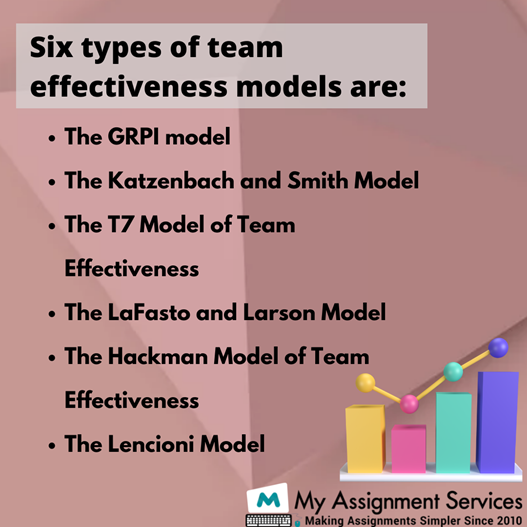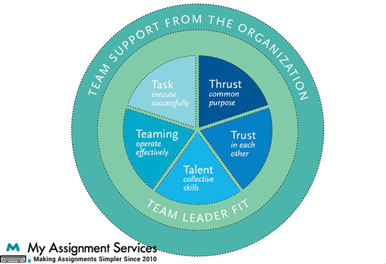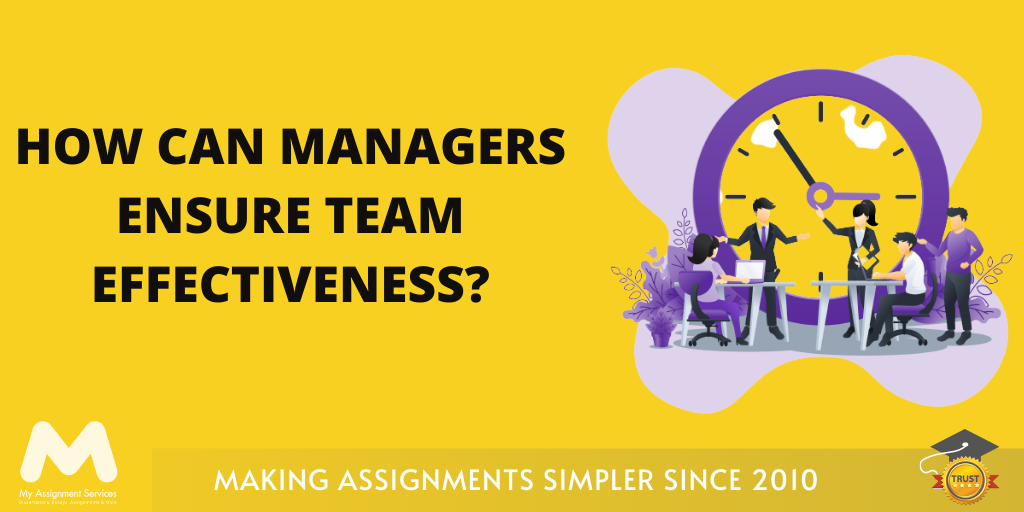Team effectiveness refers to the yield of team capacity managed by an individual or an organisation. A group of individuals has their respective tasks and responsibilities to achieve a common goal or outcome under an organisation. They function according to the requirements and protocols of the company. For enabling the team to attain their destination, the leaders need to create an effective work environment and team culture that ensures a good balance between the well-being and great performance of the team members.

Six Types Of Team Effectiveness Models That Foster Effectiveness Of A Team
There are six major team effectiveness models that we'll study to understand the functioning and effectiveness of various types of teams. Our experts, who provide management assignment help, briefly discuss the six models and see real-life examples of leading firms using multiple models for increasing their team effectiveness.
The GRPI Model
The GRPI, or the goals, roles, processes and interpersonal relationship model, was proposed in 1977 by Rubin, Plovnick and Fry. It uses a pyramid drawing to represent the models and interpersonal relationships to build team effectiveness.
The Katzenbach and Smith Model
Jon Katzenbach and Douglas Smith introduced this model in 1993 in their book 'The Wisdom of Tears'. This model is shaped like a triangle and divided into three equilateral triangles. Each small triangle represents skills, accountability, and results. Therefore, we can conclude that for this model, the basis for team effectiveness is the required skills and responsibilities of each team member to generate effective results.
The T7 Model
Proposed in 1995 by Michael Lombardo and Robert Eichinger. The T7 model refers to the five core and two causal factors affecting a team's effectiveness. This model has a circular centre divided into five partitions and two rings surrounding the core circle. The five basic T's to team effectiveness are thrust, trust, talent, team skills, task, and the other two are team leader adequacy and team support from the company.

The LaFasto and Larson Model
As referenced in the name, this model was introduced in 2001 by Frank LaFasto and Carl Larson, also known as the five attributes of teamwork and collaboration. The basic elements of this model are team members, team relationships, problem-solving, leadership, and the company environment.
The Hackman Model of Team Effectiveness
Introduced by Richard Hackman in 2002, this model outlines the five necessary conditions for effective teamwork. According to Heckman, the relationship among team members, the team's direction, enabling structure, support from the organisation, and guidance are necessary for effective teamwork.
The Lencioni Model
Different from the above models, it is shaped like a pyramid, and each level states the reason for the dysfunctional behaviour of a team. Lencioni's team effectiveness leadership model was introduced in 2005; this model explains the reasons for a team's dysfunction and its cure.
Team operation models are very useful and effective, and are used by various leading firms worldwide. Every organisation has a very well-rounded and effective team behind its operations. Popular companies like Pixar and Marvel Comics are very good examples of team effectiveness that we see in real life.
Steve Jobs, when he established the Pixar studios, changed the single cubicle work culture. He moved all the mailboxes, cafes, and shops in a common area accessible to everyone. Hence, the employees run into each other and know each other better for effective communication and teamwork. Good team leaders and team management assignments help ensure the same.
Another example is the animation work culture, the process of converting a 2-D image into a 3-D or a moving film that we see on screens requires a great deal of hard work. The process consists of artists creating scenes, colourists filling the primary colours, the scene directors adding the dialogues and additional visual effects, and then it is sent to the animation team. It is an intricate and lengthy process and requires maximum effort and patience from each team member. All these steps are interdependent and cannot be done by a single person.
How Do Leading Australian Firms Ensure Team Effectiveness?
The work environment and the support of the organisations are very important factors for team effectiveness. A company that values the skills and well-being of its employees is more likely to generate better results and is expected to work more efficiently. Leading companies like Google rank as the best place to work in the world. This is mainly due to the work environment and the employees' additional perks. Free gourmet food, laundry services, discounted gym memberships, and parental leave policy are some guidelines that ensure team members' interest in working effectively. Here are a few leading Australian companies with their team effective work models:
BHP Group Limited
BHP is an Anglo-Australian mining, metals, and petroleum company. It is by revenue Melbourne's third-largest company.
The company regards their team effectiveness on sustainability, integrity, respect, performance, simplicity and accountability.
They are putting team members' safety first and doing the right thing. Trust, teamwork, being responsible and delivering commitments are the key points of the teamwork effectiveness agenda at the BPH Group Limited.
Canva
Canva is an Australian graphic design company that creates creative digital content like posters, presentations, and other social media posts. Established in 2013, the company has shown tremendous growth, and it is mainly due to its team of 5000 members. Today, they have around 55 million users in 190 countries. They provide:
- Flexible work hours.
- Relocating budget.
- Sports and recreational activities.
- Free food for their employees.
Their goal is to make complex things easier for everyone, achieve big goals, make the world a better place through humanitarian initiatives, and empower every employee.
Macquarie
With 17000 staff working in 33 markets, Macquarie is one of Australia's top finance groups providing their customers with financial advice, management and advisory services for risk lowering. Being a vast finance service group, their major services include retail and business banking, wealth management, asset leasing, commodity trading, capital raising, and principal investment. Since 87% of the employees at this firm are financial service professionals, they are offered flexible shift hours. Such working hours allow their teammates to work effectively and efficiently as they can spend time refreshing their brains and thinking of creative solutions for their projects.
Flexible working hours allow their employees' mental and emotional well-being and enable them to recharge at their own pace. They are focused on the five possibilities of finance to manage, develop, advise, finance and create the best for their customers.
To Conclude: Ways to Ensure Team Effectiveness
All these leading companies are well focused on the well-being of their employees, not just financial, but also mental and emotional. Providing well-rounded support to teammates allows an increase in team effectiveness and helps in generating the best possible outcome for the company. In this blog, our management assignment help experts discussed the various team effectiveness models and studied the implications of the different methods used by leading firms to ensure team effectiveness. This is often overlooked as the most important reason behind a company's success, and it allows high perseverance rates among the employees of the company. Many new business models emerge every day, but we must always remember that high team effectiveness increases revenue.






